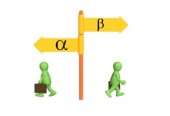 Pimco announced recently (in a January 24th filing with the SEC) that it is going to expand its offerings of active exchange-traded funds, offering 19 new flavors.
Pimco announced recently (in a January 24th filing with the SEC) that it is going to expand its offerings of active exchange-traded funds, offering 19 new flavors.
To some people, the very phrase “active ETF” may still sound puzzling. After all, haven’t ETFs acquired their prominence mostly as a cheap and transparent alternative to passive [indexed] mutual funds? Aren’t they supposed to be the quintessential passive instrument?
Well … yes and no. That is how ETFs rose to their present place in the scheme of things. But it was never a very big jump to think of an ETF as potentially accompanied by a manager making portfolio allocation decisions beyond what a simple algorithm would do in that line: changing sector allocations, timing trades, etc.
As regular readers of AllAboutAlpha may remember, we have observed here that the promoters of the trend hope that active ETFs will eventually rival active mutual funds just as the passive cousins of the one rival the cousins of the other.
Yet active ETFs are not as yet on the brink of such success. In The Cerulli Edge for January 2014, there is a good deal of material on the matter of ETFs, and much of the data it contains suggests (on my own reading, not on Cerulli’s own) that although the older passive sort of ETF yet has a big future, the active form may be about to hit a ceiling.
No Steamroller
Let’s go back to basics for a moment: ETF assets exceeded $1.6 trillion by the end of 2013. ETFs as a vehicle have certain well-known advantages vis-à-vis mutual funds: lower cost, greater transparency, and intraday trading.
Further, the mutual fund history hasn’t exactly allowed itself to be flattened by the ETF steamroller. Cerulli mentions that the MF industry recorded $282 billion in net new flows in December 2013. Why doesn’t it all end up in ETFs instead? Well, first because many of those mutual funds are actively managed, and there remain people who hope and expect that their active managers will beat the market on their behalf. Or, at least, will do the homework necessary to diversify properly on their behalf. Until quite recently any bias in favor of an active management was also a bias in favor of mutual funds in their competition with the ERTF vehicle.
But this couldn’t be a complete explanation. Passive mutual funds have survived the threat posed by their (passive) ETF rivals. This is in part a simply reflection of the fact that they’ve been around longer (about twenty years longer) and so the better of the mutual funds have built up comforting track records. In further part, mutual funds benefit from the “transaction fees” issue plaguing ETFs. Finally, there is a more technical-sounding reason for the continued vitality of these funds: periodic re-balancing of a portfolio is easier with index funds than with ETFs.
This brings us back to the Cerulli piece.
Asking the Advisors and Sponsors
Cerulli asked advisors how they use ETFs in the course of constructing a portfolio: 52% said they “often” use ETFs as “a source of cheap beta.” Another 43% say they “sometimes” use them that way. This is the use most in accord with the use of old-fashioned passive ETF.
Cerulli separately asked the sponsors of ETFs what they believe is driving the growth of the ETF industry. Fifty percent of the respondents identified “the overall popularity of passive investing” as a major driver. Another 44% said that this was a moderate driver. Only the remaining 6% said this was not a driver at all. Obviously, if the industry is still driven by the popularity of passive investing, it is because it is still identified in the minds of relevant investors and intermediaries as a passive investment.
There was another question in the survey of sponsors that serves as a great complement to that one. Sponsors were asked whether a further “breakthrough” of “active ETFs” will serve as a major driver of near-future growth of the ETF industry. Only a quarter of the respondents saw that as a major driver. Another quarter saw it as a “moderate driver.” The remaining half said that it was not a driver at all. So the sponsors themselves are not inclined to expect much of active ETFs.
A final point: both ETFs and passive mutual funds saw a strong ending to 2013 “as both vehicles pulled in positive flows into passive products in December.” In the world of active management, on the other hand, meh: Active mutual funds experienced four months of net outflows.



